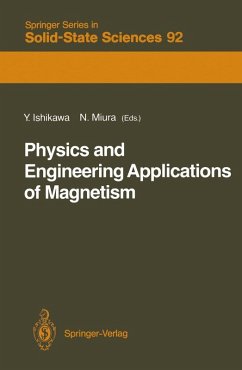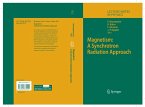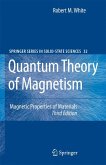Physics and Engineering Applications of Magnetism (eBook, PDF)
Redaktion: Ishikawa, Yoshikazu; Miura, Noboru
40,95 €
40,95 €
inkl. MwSt.
Sofort per Download lieferbar

20 °P sammeln
40,95 €
Als Download kaufen

40,95 €
inkl. MwSt.
Sofort per Download lieferbar

20 °P sammeln
Jetzt verschenken
Alle Infos zum eBook verschenken
40,95 €
inkl. MwSt.
Sofort per Download lieferbar
Alle Infos zum eBook verschenken

20 °P sammeln
Physics and Engineering Applications of Magnetism (eBook, PDF)
Redaktion: Ishikawa, Yoshikazu; Miura, Noboru
- Format: PDF
- Merkliste
- Auf die Merkliste
- Bewerten Bewerten
- Teilen
- Produkt teilen
- Produkterinnerung
- Produkterinnerung

Bitte loggen Sie sich zunächst in Ihr Kundenkonto ein oder registrieren Sie sich bei
bücher.de, um das eBook-Abo tolino select nutzen zu können.
Hier können Sie sich einloggen
Hier können Sie sich einloggen
Sie sind bereits eingeloggt. Klicken Sie auf 2. tolino select Abo, um fortzufahren.

Bitte loggen Sie sich zunächst in Ihr Kundenkonto ein oder registrieren Sie sich bei bücher.de, um das eBook-Abo tolino select nutzen zu können.
Physics and Engineering Applications of Magnetism deals with one of the most important and fundamental research subjects in solid-state physics. For the first time a unified treatment of both the basic physics and the technological applications of magnetism is given. Among the topics discussed are: the generation and application of ultra-high magnetic fields; compound, amorphous, and thin-film magnetic materials; magneto-optic recording; and the imaging of magnetic domains.
- Geräte: PC
- ohne Kopierschutz
- eBook Hilfe
- Größe: 28.23MB
Andere Kunden interessierten sich auch für
![Magnetic Domains (eBook, PDF) Magnetic Domains (eBook, PDF)]() Alex HubertMagnetic Domains (eBook, PDF)232,95 €
Alex HubertMagnetic Domains (eBook, PDF)232,95 €![Magnetism: A Synchrotron Radiation Approach (eBook, PDF) Magnetism: A Synchrotron Radiation Approach (eBook, PDF)]() Magnetism: A Synchrotron Radiation Approach (eBook, PDF)40,95 €
Magnetism: A Synchrotron Radiation Approach (eBook, PDF)40,95 €![The Theory of Magnetism II (eBook, PDF) The Theory of Magnetism II (eBook, PDF)]() Daniel C. MattisThe Theory of Magnetism II (eBook, PDF)40,95 €
Daniel C. MattisThe Theory of Magnetism II (eBook, PDF)40,95 €![Magnetic Excitations and Fluctuations (eBook, PDF) Magnetic Excitations and Fluctuations (eBook, PDF)]() Magnetic Excitations and Fluctuations (eBook, PDF)72,95 €
Magnetic Excitations and Fluctuations (eBook, PDF)72,95 €![Quantum Theory of Magnetism (eBook, PDF) Quantum Theory of Magnetism (eBook, PDF)]() Robert M. WhiteQuantum Theory of Magnetism (eBook, PDF)167,95 €
Robert M. WhiteQuantum Theory of Magnetism (eBook, PDF)167,95 €![Solid · State Magnetism (eBook, PDF) Solid · State Magnetism (eBook, PDF)]() John CrangleSolid · State Magnetism (eBook, PDF)40,95 €
John CrangleSolid · State Magnetism (eBook, PDF)40,95 €![Proceedings of the Seventh Conference on Magnetism and Magnetic Materials (eBook, PDF) Proceedings of the Seventh Conference on Magnetism and Magnetic Materials (eBook, PDF)]() J. A. OsbornProceedings of the Seventh Conference on Magnetism and Magnetic Materials (eBook, PDF)40,95 €
J. A. OsbornProceedings of the Seventh Conference on Magnetism and Magnetic Materials (eBook, PDF)40,95 €-
-
-
Physics and Engineering Applications of Magnetism deals with one of the most important and fundamental research subjects in solid-state physics. For the first time a unified treatment of both the basic physics and the technological applications of magnetism is given. Among the topics discussed are: the generation and application of ultra-high magnetic fields; compound, amorphous, and thin-film magnetic materials; magneto-optic recording; and the imaging of magnetic domains.
Dieser Download kann aus rechtlichen Gründen nur mit Rechnungsadresse in A, B, BG, CY, CZ, D, DK, EW, E, FIN, F, GR, HR, H, IRL, I, LT, L, LR, M, NL, PL, P, R, S, SLO, SK ausgeliefert werden.
Produktdetails
- Produktdetails
- Verlag: Springer Berlin Heidelberg
- Seitenzahl: 317
- Erscheinungstermin: 6. Dezember 2012
- Englisch
- ISBN-13: 9783642841583
- Artikelnr.: 53103507
- Verlag: Springer Berlin Heidelberg
- Seitenzahl: 317
- Erscheinungstermin: 6. Dezember 2012
- Englisch
- ISBN-13: 9783642841583
- Artikelnr.: 53103507
- Herstellerkennzeichnung Die Herstellerinformationen sind derzeit nicht verfügbar.
Physics and Engineering Applications of Magnetism deals with one of the most important and fundamental research subjects in solid-state physics. For the first time a unified treatment of both the basic physics and the technological applications of magnetism is given. Among the topics discussed are: the generation and application of ultra-high magnetic fields; compound, amorphous, and thin-film magnetic materials; magneto-optic recording; and the imaging of magnetic domains.
1. Progress in the Physics of Magnetism in the Past Forty-five Years.- 1.1 Magnetism of 3d Transition Metals and Alloys.- 1.2 Magnetism of Rare Earth Metals and Alloys.- 1.3 Magnetism of Ferrimagnetic Oxides.- 1.4 Observation of Ferromagnetic Domains.- 1.5 Experimental Techniques and Environments.- 1.6 Engineering Applications of Magnetic Materials.- 1.7 Conclusions.- References.- 2. Generation of Megagauss Magnetic Fields and Their Application to Solid State Physics.- 2.1 Various Techniques for Generating Ultra-high Magnetic Fields.- 2.2 Electromagnetic Flux-Compression.- 2.3 Single-Turn Coil Technique.- 2.4 Magnetism Experiments in Megagauss Fields.- References.- 3. Magnetism in Metals and Alloys Studied by Neutron Scattering.- 3.1 Significance of Neutron Scattering for the Study of Magnetism.- 3.2 Studies of Antiferromagnetic Metals with Elastic Scattering.- 3.3 Ferromagnetic Metals Studied by Inelastic Scattering.- 3.4 Spin Dynamics in Localized Spin Systems.- 3.5 Spin Dynamics in Itinerant Electron Systems.- 3.6 Spin Dynamics in Quasi-Localized Spin Systems.- 3.7 Dynamic Behavior of Invar Alloys.- 3.8 Epilogue - The Magnetism of Fe and Ni.- Addendum.- References.- 4. Magnetic Properties of 3d Compounds with Special Reference to Pyrite Type Compounds.- 4.1 General Survey of 3d Magnetic Compounds.- 4.2 Experimental Results.- 4.3 Theoretical Interpretation.- References.- 5. Invar Systems.- 5.1 Magnetovolume Effects.- 5.2 Invar Type Alloys.- 5.3 Elasticity.- 5.4 Conclusions.- References.- 6. Magnetic Anisotropy and Magnetostriction.- 6.1 Magnetocrystalline Anisotropy.- 6.2 Magnetostriction.- 6.3 Representative Materials and Topics.- 6.4 Realization of High Magnetic Permeability. "The Focus of Zero" in Magnetic Anisotropy and Magnetostriction.- 6.5 InducedMagnetic Anisotropy. How to Control the Shape of Magnetization Curves.- References.- 7. The Intermediate Field Between Pure and Applied Magnetism. Importance of Accurate Measurements of Magnetization Curves.- 7.1 Technical Terms and Figures.- 7.2 Estimation of Saturation Magnetization and Curie Temperatures.- 7.3 Magnetic Anisotropy.- 7.4 Magnetostriction and Magneto-elastic Energy.- 7.5 Spin Glasses, Hopkinson Effect and the Invar Problem.- 7.6 The Problem of Communication Between Applied Researchers and Those in the "Intermediate Fields" or in Basic Research.- 7.7 Conclusion.- References.- 8. Amorphous Magnetic Materials.- 8.1 Magnetization and Temperature Dependence of Amorphous Magnetic Materials.- 8.2 Magnetic Anisotropy.- 8.3 Magnetism, Preparation Conditions and Structural Relaxation of Amorphous Alloys.- References.- 9. Amorphous Magnetic Alloy Ribbons and Their Applications.- 9.1 Materials.- 9.2 Applications.- References.- 10. Magneto-optical Recording.- 10.1 Principles of Recording, Reproducing and Erasing.- 10.2 Requirements for Recording Media.- 10.3 Recording Media.- 10.4 Dynamic Read Write Properties.- 10.5 Applications and Other Technologies.- References.- 11. Magnetic Bubble Memories. Solid State File Utilizing Micro Magnetic Domains.- 11.1 Physics of Magnetic Bubbles.- 11.2 Magnetic Bubble Materials.- 11.3 Magnetic Bubble Devices.- 11.4 Magnetic Bubble Memories and Applications.- 11.5 Future Trends of Magnetic Bubble Devices and Memories.- 11.6 Summary.- References.- 12. High Density Magnetic Recording. Recent Developments in Magnetic Tapes, Discs and Heads.- 12.1 Physics of Magnetic Recording.- 12.2 Magnetic Tapes and Discs.- 12.3 Magnetic Heads.- 12.4 Future Trends.- References.- 13. Magnetic Domains Observed by Electron Holography.- 13.1Principles of Electron Holography.- 13.2 Principles of Domain Structure Observation.- 13.3 Applications of Magnetic Domain Structure Observation.- 13.4 Summary.- References.- Appendix: Notes on Technical Terms.
1. Progress in the Physics of Magnetism in the Past Forty-five Years.- 1.1 Magnetism of 3d Transition Metals and Alloys.- 1.2 Magnetism of Rare Earth Metals and Alloys.- 1.3 Magnetism of Ferrimagnetic Oxides.- 1.4 Observation of Ferromagnetic Domains.- 1.5 Experimental Techniques and Environments.- 1.6 Engineering Applications of Magnetic Materials.- 1.7 Conclusions.- References.- 2. Generation of Megagauss Magnetic Fields and Their Application to Solid State Physics.- 2.1 Various Techniques for Generating Ultra-high Magnetic Fields.- 2.2 Electromagnetic Flux-Compression.- 2.3 Single-Turn Coil Technique.- 2.4 Magnetism Experiments in Megagauss Fields.- References.- 3. Magnetism in Metals and Alloys Studied by Neutron Scattering.- 3.1 Significance of Neutron Scattering for the Study of Magnetism.- 3.2 Studies of Antiferromagnetic Metals with Elastic Scattering.- 3.3 Ferromagnetic Metals Studied by Inelastic Scattering.- 3.4 Spin Dynamics in Localized Spin Systems.- 3.5 Spin Dynamics in Itinerant Electron Systems.- 3.6 Spin Dynamics in Quasi-Localized Spin Systems.- 3.7 Dynamic Behavior of Invar Alloys.- 3.8 Epilogue - The Magnetism of Fe and Ni.- Addendum.- References.- 4. Magnetic Properties of 3d Compounds with Special Reference to Pyrite Type Compounds.- 4.1 General Survey of 3d Magnetic Compounds.- 4.2 Experimental Results.- 4.3 Theoretical Interpretation.- References.- 5. Invar Systems.- 5.1 Magnetovolume Effects.- 5.2 Invar Type Alloys.- 5.3 Elasticity.- 5.4 Conclusions.- References.- 6. Magnetic Anisotropy and Magnetostriction.- 6.1 Magnetocrystalline Anisotropy.- 6.2 Magnetostriction.- 6.3 Representative Materials and Topics.- 6.4 Realization of High Magnetic Permeability. "The Focus of Zero" in Magnetic Anisotropy and Magnetostriction.- 6.5 InducedMagnetic Anisotropy. How to Control the Shape of Magnetization Curves.- References.- 7. The Intermediate Field Between Pure and Applied Magnetism. Importance of Accurate Measurements of Magnetization Curves.- 7.1 Technical Terms and Figures.- 7.2 Estimation of Saturation Magnetization and Curie Temperatures.- 7.3 Magnetic Anisotropy.- 7.4 Magnetostriction and Magneto-elastic Energy.- 7.5 Spin Glasses, Hopkinson Effect and the Invar Problem.- 7.6 The Problem of Communication Between Applied Researchers and Those in the "Intermediate Fields" or in Basic Research.- 7.7 Conclusion.- References.- 8. Amorphous Magnetic Materials.- 8.1 Magnetization and Temperature Dependence of Amorphous Magnetic Materials.- 8.2 Magnetic Anisotropy.- 8.3 Magnetism, Preparation Conditions and Structural Relaxation of Amorphous Alloys.- References.- 9. Amorphous Magnetic Alloy Ribbons and Their Applications.- 9.1 Materials.- 9.2 Applications.- References.- 10. Magneto-optical Recording.- 10.1 Principles of Recording, Reproducing and Erasing.- 10.2 Requirements for Recording Media.- 10.3 Recording Media.- 10.4 Dynamic Read Write Properties.- 10.5 Applications and Other Technologies.- References.- 11. Magnetic Bubble Memories. Solid State File Utilizing Micro Magnetic Domains.- 11.1 Physics of Magnetic Bubbles.- 11.2 Magnetic Bubble Materials.- 11.3 Magnetic Bubble Devices.- 11.4 Magnetic Bubble Memories and Applications.- 11.5 Future Trends of Magnetic Bubble Devices and Memories.- 11.6 Summary.- References.- 12. High Density Magnetic Recording. Recent Developments in Magnetic Tapes, Discs and Heads.- 12.1 Physics of Magnetic Recording.- 12.2 Magnetic Tapes and Discs.- 12.3 Magnetic Heads.- 12.4 Future Trends.- References.- 13. Magnetic Domains Observed by Electron Holography.- 13.1Principles of Electron Holography.- 13.2 Principles of Domain Structure Observation.- 13.3 Applications of Magnetic Domain Structure Observation.- 13.4 Summary.- References.- Appendix: Notes on Technical Terms.







